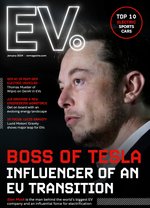Some global disruption plagued electrification efforts in 2023. Despite this, companies were able to make great strides in adopting new-energy solutions and increasing the number of electric vehicles (EVs) on the roads. Things seem to be looking upwards as a result of this, but if last year is anything to go by then more major shifts are expected to take place in 2024.
This will be informed by new updates from COP28 and inevitable shifts in how countries interact with the markets of others—now that barriers are reduced and the leading automakers are looking to soak up their share of global zero-emission vehicle (ZEV) trade.
Speaking on this is Randall ‘Randy’ Miller, the Global Advanced Manufacturing & Mobility Leader at EY, who is also a key stakeholder in the EV industry with insights into the market trends and what to expect from the global market this year.
What were the most significant changes within the EV industry in 2023?
The EV industry witnessed a significant growth in global sales in 2023—BEV and PHEV—reaching approximately 14m (LVs), marking a 33% year-on-year (YoY) increase, while average global battery prices dropped by around 14% YoY, providing automakers additional room to reduce costs. This is slowly resulting in EVs transition beyond the early adopters to the mass market. At the same time, hybrids have also witnessed significant growth in major markets, especially in China where it now accounts for 12% of total passenger vehicle sales.
However, global EV sales growth has recently slowed due to a weakened economic outlook and rising interest rates, hindering the anticipated EV transition, leading key players to re-evaluate their EV strategies. Amid slowing sales in the world’s largest EV market China, many Chinese players are increasingly exploring the EU market with cheaper EVs, resulting in retaliatory measures from European OEMs. The ongoing EV price war has also impacted profitability for most OEMs, especially EV start-ups, triggering a possible industry consolidation, especially in China.
Geopolitical tensions and trade wars influenced the overall dynamics of the EV ecosystem, prompting leading companies to invest in nearshoring to minimise costs and risks. While charging infrastructure has improved, it remains a hurdle for wide-spread EV adoption, with an estimated need for 20m global public chargers by 2030, against circa 5m in 2023.
In regulatory moves, policies like the EU’s 2035 ICE phase-out and the US IRA and IIJA have encouraged significant public-private investments. Also, high EV penetration markets like China, Germany and Norway are now focusing more on EV infrastructure development, reallocating upfront subsidies.
What trends can we expect to see in 2024?
The growth of EV sales is expected to be lower than what was previously anticipated, as macroeconomic challenges and higher interest rates are likely to dampen consumer appetite for EV financing. However, in the long run I expect EVs to regain their initial growth trajectory as declining battery prices will help OEMs develop more attractive pricing strategies for the mass market. We expect more collaborations and technology sharing between global OEMs and other industry players to reduce cost of development and go to market time.
To enable this growth trajectory, there still needs to be improvements in a number of fundamental areas that remain a challenge. The ultimate goal should be for EV’s to be the desired choice of the consumer among choices including ICE vehicles.
Continued progress in charging infrastructure, range, choice and cost remain key.
Our recent Mobility Consumer Index survey showed that 31% of those not looking to buy an EV cite lack of charging stations as the reason for their scepticism. However, improving availability and convenience will assist in mitigating some of the long-held issues about EV chargers. We have also seen more and more prominent automakers adopting North American Charging Standard (NACS), which will help to alleviate range anxiety fears due to greater availability and faster charging speed.
In 2024, there will be increased focus on incorporating new battery chemistries, especially the cathode to minimise use of expensive metals such as lithium, nickel and cobalt. At the same time, in a bid to become self-reliant, several countries
especially the US and EU are expected to further ramp up investments in the battery ecosystem.
China will continue to be the largest global EV market, while EU and the US markets are projected to experience considerable growth in terms of EV adoption.
However, geopolitical uncertainties and trade wars can have significant impact on EV supply chain, potentially impacting overall adoption.
Key points to take away
Firstly, there’s the blip in EV sales. Although China witnessed slowing sales towards the end of last year, Miller suggests this is remedied by a pivot towards cost reduction within the EU market. While European countries are coming on board with EVs, the restriction they face is the cost of manufacturing, which inherently becomes a cost to the consumer.
The Second point—a potential saving grace for some buyers—is the reduction in battery prices, which will buffer the slowing demand in the industry, yet still plays into the hands of Chinese automakers as they continue to dominate low-cost electrification. The reduction in battery costs is a blanket change that will hopefully allow continued trade of EVs and encourage more drivers to make the switch, but the industry must not underestimate the constraints on consumers as the cost-of-living challenges a lot of countries are impacted by global energy supply disruption.
In terms of charging, consumers are still concerned about the number of charging stations available to them. The global heavy-duty charger market is expected to exceed double the market value of 2022 and become around 1.5 times larger than in 2023.
**************
Make sure you check out the latest edition of EV Magazine and also sign up to our global conference series - Sustainability LIVE 2024
**************
EV Magazine is a BizClik brand



